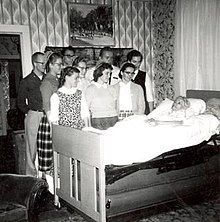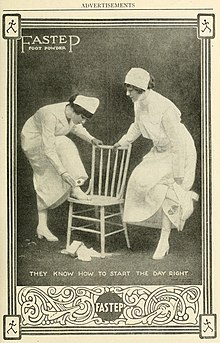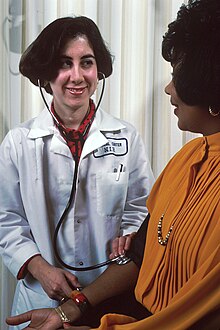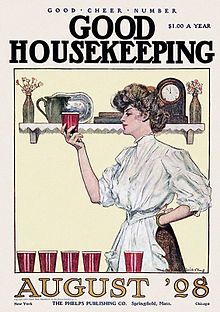Nursing home care

Rear admiral James A. Symonds talking to a resident of a nursing home in Spokane, Washington, August 2008
Nursing homes, also known as old people's homes,[1]care homes, rest homes, and convalescent homes, provide residential care for elderly or disabled people that often includes around-the-clock nursing care.[2] Often these terms have slightly different meanings in the same or different English-speaking countries to indicate that the institutions are public or private or provide mostly assisted living or more or less nursing care and emergency medical care. A nursing home is a place for people who don't need to be in a hospital but can't be cared for at home. Most nursing homes have nursing aides and skilled nurses on hand 24 hours a day. Some nursing homes also provide short-term rehabilitative stays following surgery, illness, or injury. Services may include physical therapy, occupational therapy, or speech-language therapy. Nursing homes also offer other services, such as planned activities and daily housekeeping. Nursing homes may also be referred to as convalescent care, skilled nursing or a long-term facility. Nursing homes may offer memory care services.[3]
Contents
1 History
2 Staff
2.1 Nurses
2.2 Nursing assistants
2.3 Administration
2.4 Housekeeping
2.5 Recreational staff
3 Therapy
3.1 Occupational therapy
3.2 Physical therapy
3.3 Speech language therapy
4 By country
4.1 Canada
4.2 United Kingdom
4.3 United States
5 See also
6 References
History


Poorhouses/workhouses were the first implemented national framework to provide a basic level of care to the old and infirm. Pictured, is "The workroom at St James's workhouse" from The Microcosm of London (1808).
Starting in the 17th century, the concept of poorhouses (also referred to as almshouses) were brought to America by English settlers. All orphans, mentally ill and the poor elderly were placed into these living commons. In the twenty-first century, nursing homes have become a standard form of care for the most aged and incapacitated persons. Nearly 6 percent of older adults are sheltered in residential facilities that provide a wide range of care. Yet such institutions have not always existed; rather, their history and development reflect relatively recent demographic and political realities that shape the experience of growing old. Before the nineteenth century, no age-restricted institutions existed for long-term care. Rather, elderly individuals who needed shelter because of incapacity, impoverishment, or family isolation often ended their days in an almshouse. Placed alongside the insane, the inebriated, or the homeless, they were simply categorized as part of the community's most needy recipients.These poorhouses gave a place where they could be given shelter and daily meals. Poorhouses continued to exist into the early 20th century despite the criticism they faced. Much of the criticism stemmed from the conditions of the poorhouses. The Great Depression overwhelmed the poorhouses as there were a lot of people that needed help and care but not enough space and funding in the poorhouses. Due to Muck Raking in the 1930s the less than favorable living conditions of the poorhouses were exposed to the public.[4] Poorhouses were then replaced with a different type of residential living for the elderly. These new residential living homes were called board-and-care homes or also known as convalescent homes. These board-and-care homes would provide basic levels of care and meals in a private setting for a specific fee. Board-and-care homes proved to be a success and by World War 2, the new way of nursing homes began to take shape. As the times continued to change, the government identified the issue of people spending extensive amounts of time in hospitals. To combat these long stays in short-term settings, board-and-care homes began to convert into something more public and permanent that was state and federally funded. From this, by 1965 nursing homes were a solid fixture. Nursing homes were a permanent residence where the elderly and disabled (poor elderly and disabled specifically) could receive any necessary medical care and receive daily meals. Though nursing homes in the beginning were not perfect, they were a huge step above almshouses and poorhouses in regards to following laws and maintaining cleanliness. From the 1950s through the 1970s the dynamics of nursing homes began changing significantly. Medicare and Medicaid began to make up much of the money that would filter through the homes and the 1965 amendment laws enforced nursing homes to comply with safety codes and required registered nurses to be on hand at all times. Additionally, nursing homes may sue children for the costs of caring for their parents in jurisdictions which have filial responsibility laws. Later in 1987, the Nursing Reform Act was introduced to begin defining the different types of nursing home services and later added the Residents' Bill of Rights.[5] Today nursing homes are very different across the board. Some nursing homes still resemble a hospital while others look more like a home. Nursing home residents can pay for their care out of pocket, others may receive medicare for a short time and some may use long-term insurance plans. Across the spectrum, most nursing homes will accept medicaid as a source of payment.[6]
Staff
In most jurisdictions, nursing homes are required to provide enough staff to adequately care for residents. In the U.S., for instance, nursing homes must have at least one registered nurse (RN) available for at least 8 straight hours a day throughout the week, and at least one licensed practical nurse (LPN) on duty 24 hours a day.[7] Direct care nursing home employees usually include registered nurses, licensed practical nurses, certified nursing assistants, and physical therapists, amongst others.
Nurses

Nursing homes require that a registered nurse (RN) be present to assess and monitor residents. The RN's job duties include implementing care plans, administering medications, recording and maintaining accurate reports for each resident, monitoring and recording medical changes and providing direction to the nursing assistants and licensed practical nurses (LPN).[8] The LPN monitors residents’ well-being and administers treatments and medications, such as dressing wounds and dispensing prescribed drugs.
Nursing assistants

A nursing assistant provides basic care to patients while working directly under a LPN or RN. These basic care activities, also referred to as activities of daily living, can include assisting with bathing and dressing residents, helping residents with meals, either serving them or with feeding, transferring to and from the bed or wheelchair, making and cleaning beds, assisting with toileting, and answering call lights.[9] Nursing assistants' official titles can vary between jurisdictions and facilities. They can include Certified Nursing Assistants (CNA's), nursing aides, caregivers, patient care associates, patient care technicians, and care assistants.
Administration
Depending on the size of the nursing home, a nursing home may have either a nursing home administrator or an executive director. Some nursing homes may have both, but their job duties are similar and can include overseeing staff, supplying medical supplies, and financial matters. Some nursing homes also have human resources personnel, who are in charge of all aspects of hiring new employees. Human resources job duties vary but can also include coordinating payroll, organizing orientation programs for new employees, interviewing, disciplinary actions, and ensuring compliance with federal and state laws.[10] Nursing homes are usually licensed and heavily regulated under governing legislation. Compliance with the federal and state legislatures are reviewed regularly for adherence to strict standards of building codes, care plans, behavior and altercations between residents, nutrition and dietary services, medical services, nursing and personal care, religious and spiritual practices, pets, and recreational programs.[11]
Housekeeping

Housekeepers are an important part of up keeping nursing homes. Housekeepers play a huge part in ensuring that nursing homes are kept clean and free of disease causing agents. Housekeepers have a long list of duties which include cleaning floors, changing linens, disinfecting bathrooms, changing towels, washing clothes, emptying garbage cans, sanitizing rooms, replenishing supplies, dusting and polishing furniture, vacuuming, and keeping windows and woodwork clean. These duties can be different from facility to facility but will overall include basic cleaning. Housekeeping does not require any licensure or schooling, but some housekeeping jobs may prefer prior job experience.[12]
Recreational staff
Recreational staff usually include an activity director and possibly activity assistants depending on the size of the nursing home. Activities aim to meet each residents' emotional, intellectual, physical, social, spiritual, and vocational needs. The transition from being independent to having to depend on others and be away from home is oftentimes very difficult, which is why activities are important to combat depression and anxiety.[13] Some of the different activities that may be offered include hosting birthday parties, celebrating holidays, book clubs, musical events, outdoor activities, discussion and social groups, exercise, arts and crafts, pet therapy, religious services and community outings. Volunteer involvement is also an important part of nursing home activities given that volunteers can act as a link between the nursing home and the outside community.[14]
Therapy
Occupational therapy
One of the many services offered in a nursing home is occupational therapy. Occupational therapy may be necessary following an injury or illness in order to regain skills and to receive support during any physical or cognitive changes.[15] Occupational therapy will focus on activities of daily living such as bathing, dressing, grooming. Occupational therapy also assists with instrumental activities of daily living which include home and financial management, rest and sleep, education, work, play, leisure, and social participation. Occupational therapists work to allow the person to safely and comfortably reintegrate into society by practicing public dining, transferring to different surfaces (chairs, beds, couches etc.), and will assess the need for any home modifications or safety equipment to ensure a proper and safe transition. When a cognitive and/or perceptual deficit is presented, therapists will work with the person by teaching strategies to maximize memory, sequencing and attention span length. [16]
Physical therapy

Another important service found in a nursing home is physical therapy. Physical therapy may be necessary following an injury, illness or surgery. Physical therapy works with the person to help them regain strength, endurance, flexibility, balance and range of motion.[17] Physical therapy is also used as a way of preventing injuries and accidents by focusing on restoring mobility, increasing fitness levels, reducing pain and overall reaching a certain point of independence. There are many conditions that can benefit from receiving physical therapy in a nursing home, these conditions include arthritis, pain associated with cancer, dementia, Alzheimer's, stroke and incontinence.[18][19]
Speech language therapy

Speech-language pathology is another service found in a nursing home. Speech language pathologists specialize in working with those who have a difficult time with language and/or speech, usually following an injury or an underlying diagnoses.[20] The SLP will evaluate the persons speech. If the person is having trouble with speech, this points to an issue with coordinating the movements and muscles used to produce speech. While trouble with language points to the person having difficulty with understanding what they are hearing and seeing. The SLP will also look at difficulty with swallowing food and will evaluate the person in order to figure out which part of the swallowing process is not working. Some of the many speech disorders worked with by the SLP are; Phonology meaning the speech patterns used, Apraxia meaning difficulty with coordinating the movements needed to make sounds, Receptive Language meaning difficulty understanding language, Fluency meaning stuttering, Expressive Language meaning difficulty using language and many other disorders. [21]
By country
Canada
Long-term care facilities exist under three major types: privately owned, non-profit/charitable, and municipal. Regardless of their ownership, aspects of funding, admission criteria, and cost to the individuals are all regulated by their respective provincial governments.[22] As medical care is publicly funded in Canada, all long-term care facilities receive funding from provincial governments for the health care component of the residence – the nurses and personal support workers. Residents pay daily rates for 'room and board' (accommodation and food) that are determined by the type of room chosen, either shared or private. Provincial governments manage waiting lists for long-term care facilities. People who cannot afford to pay the monthly fees receive subsidies, and no one is refused due to inability to pay.[23]
United Kingdom
In the United Kingdom, care homes and care homes with nursing are regulated by different organisations in England, Scotland, Wales and Northern Ireland. To enter a care home, a candidate patient needs an assessment of needs and of their financial condition from their local council. The candidate may also have an assessment by a nurse, should the patient require nursing care. The cost of a care home is means tested in England.
Care homes for adults in England are regulated by Care Quality Commission, which replaced the Commission for Social Care Inspection, and each care home is inspected at least every three years. In Wales the Care Standards Inspectorate for Wales has responsibility for oversight, In Scotland Social Care and Social Work Improvement Scotland otherwise known as the Care Inspectorate, and in Northern Ireland the Regulation and Quality Improvement Authority in Northern Ireland.
In 2002, nursing homes became known as care homes with nursing, and residential homes became known as care homes.[24]
As of April 2009 in England, the lower capital limit is £13,500. At this level, all income from pensions, savings, benefits and other sources, except a "personal expenses allowance" (currently £21.90), goes towards paying the care home fees. The local council pays the remaining contribution provided the room occupied is not more expensive than the local council's normal rate.[25]
The NHS has full responsibility for funding the whole placement if the resident is in a care home with nursing that meets the criteria for NHS continuing Health Care. This is identified by a multidisciplinary assessment process.[26]
In May 2010, the Coalition Government announced the formation of an independent commission on the funding of long-term care, which was due to report within a 12-month time frame on the financing of care for an Ageing population. It delivered its recommendations on Monday 4 July 2011. The Care Quality Commission have themselves implemented a re-registration process, completed in October 2010, which will result in a new form of regulation being outlined in April 2011.[27]
United States
In the United States there are three types of nurses in a nursing facility. There are Registered Nurses(RN), Licenced Practical Nurse(LPN), and Certified Nursing Assistant(CNA. The LPN monitors residents’ well-being and administers treatments and medications, such as dressing wounds and dispensing prescribed drugs. An LPN's responsibility is to be the patients bed-side care and they carry out a daily routine of caring for the patients hygiene and day to day care.
In the United States, there are three main types of nursing facilities (NFs).
An intermediate care facility (ICF) is a health care facility for individuals who are disabled, elderly, or non-acutely ill, usually providing less intensive care than that offered at a hospital or skilled nursing facility. Typically an ICF is privately paid by the individual or by the individual's family. An individual's private health insurance and/or a third party service like a hospice company may cover the cost. Board and Care Homes are special facilities designed to provide those who require assisted living services both living quarters and proper care. Often referred to as residential care homes, these facilities can either be located in a small residential home or a large modern facility. In fact, a large majority of board and care homes are designed to room less than 6 people. Board and care homes are typically staffed by licensed professionals, including nurses, doctors and other medical professionals. These facilities are highly regulated in order to ensure that the best possible care is being provided for the residents. Board and care homes offer residents 24 hour assistance, making them a highly popular choice for those in need of regular assistance.
Assisted living residences or assisted living facilities (ALFs) are housing facilities for people with disabilities. These facilities provide supervision or assistance with activities of daily living (ADLs); ALFs are an eldercare alternative on the continuum of care for people, for whom independent living is not appropriate but who do not need the 24-hour medical care provided by a nursing home and are too young to live in a retirement home. Assisted living is a philosophy of care and services promoting independence and dignity.[28]
A skilled nursing facility (SNF) is a nursing home certified to participate in, and be reimbursed by Medicare. Medicare is the federal program primarily for the aged (65+) who contributed to Social Security and Medicare while they were employed. Medicaid is the federal program implemented with each state to provide health care and related services to those who are below the poverty line. Each state defines poverty and, therefore, Medicaid eligibility. Those eligible for Medicaid may be low-income parents, children, including State Children's Health Insurance Programs (SCHIPs) and maternal-child wellness and food programs.[citation needed] seniors, and people with disabilities.
The Centers for Medicare and Medicaid Services is the component of the U.S. Department of Health and Human Services (DHHS) that oversees Medicare and Medicaid. A large portion of Medicare and Medicaid dollars is used each year to cover nursing home care and services for the elderly and disabled. State governments oversee the licensing of nursing homes. In addition, states have a contract with CMS to monitor those nursing homes that want to be eligible to provide care to Medicare and Medicaid beneficiaries. Congress established minimum requirements for nursing homes that want to provide services under Medicare and Medicaid. These requirements are broadly outlined in the Social Security Act, which also entrusts the Secretary of Health and Human Services with the responsibility of monitoring and enforcing these requirements. CMS is also charged with the responsibility of working out the details of the law and how it will be implemented, which it does by writing regulations and manuals.[29]
See also
Care Quality Commission previously known as Commission for Social Care Inspection
- Certified Medical Director
- Eldercare
- Home care
- International Association for Homes and Services for the Aging
- LGBT ageing
- List of companies operating nursing homes
- Retirement village
References
^ old people's home in the Cambridge Advanced Learner's Dictionary
^ "Types of Care Facilities". Care givers library..mw-parser-output cite.citation{font-style:inherit}.mw-parser-output .citation q{quotes:"""""""'""'"}.mw-parser-output .citation .cs1-lock-free a{background:url("//upload.wikimedia.org/wikipedia/commons/thumb/6/65/Lock-green.svg/9px-Lock-green.svg.png")no-repeat;background-position:right .1em center}.mw-parser-output .citation .cs1-lock-limited a,.mw-parser-output .citation .cs1-lock-registration a{background:url("//upload.wikimedia.org/wikipedia/commons/thumb/d/d6/Lock-gray-alt-2.svg/9px-Lock-gray-alt-2.svg.png")no-repeat;background-position:right .1em center}.mw-parser-output .citation .cs1-lock-subscription a{background:url("//upload.wikimedia.org/wikipedia/commons/thumb/a/aa/Lock-red-alt-2.svg/9px-Lock-red-alt-2.svg.png")no-repeat;background-position:right .1em center}.mw-parser-output .cs1-subscription,.mw-parser-output .cs1-registration{color:#555}.mw-parser-output .cs1-subscription span,.mw-parser-output .cs1-registration span{border-bottom:1px dotted;cursor:help}.mw-parser-output .cs1-ws-icon a{background:url("//upload.wikimedia.org/wikipedia/commons/thumb/4/4c/Wikisource-logo.svg/12px-Wikisource-logo.svg.png")no-repeat;background-position:right .1em center}.mw-parser-output code.cs1-code{color:inherit;background:inherit;border:inherit;padding:inherit}.mw-parser-output .cs1-hidden-error{display:none;font-size:100%}.mw-parser-output .cs1-visible-error{font-size:100%}.mw-parser-output .cs1-maint{display:none;color:#33aa33;margin-left:0.3em}.mw-parser-output .cs1-subscription,.mw-parser-output .cs1-registration,.mw-parser-output .cs1-format{font-size:95%}.mw-parser-output .cs1-kern-left,.mw-parser-output .cs1-kern-wl-left{padding-left:0.2em}.mw-parser-output .cs1-kern-right,.mw-parser-output .cs1-kern-wl-right{padding-right:0.2em}
^ Esposito, Lisa (1 June 2016). "What Nursing Home 'Memory Care' Means". U.S. News & World Report. Retrieved 29 July 2017.
^ Watson, Sidney D. "From Almshouses to Nursing Homes and community care: Lessons from Medicaid History". Georgia State University Law Review. 26.
^ "History of Nursing Homes". SeniorAdvisor.com.
^ "Paying for Nursing Home Care". Medicare.gov.
^ "nursing home staff". skillednursingfacilities.org. Retrieved 12 October 2012.
^ "What Nurses Do". American Nurses Association.
^ "What You'll Do As A CNA". AllNursingSchools.com.
^ "Human Resources". HealthCareers.com.
^ http://www.health.gov.on.ca/en/public/programs/ltc/docs/ltcha_guide_phase1.pdf
A Guide to the Long-Term Care Homes Act, 2007 and Regulation 79/10
^ "Job Description of Senior Living Housekeeper". Work.Chron.Com.
^ Petrea, RN, Jennifer. "Importance of Being Social in a Nursing Home". McKnights.
^ "Activities Defined". TheActivityDirectorsOffice.com.
^ "About Occupational Therapy". AOTA.org.
^ "Occupational Therapy's Role in Skilled Nursing Facility's" (PDF). AOTA.org.
^ "How Do I Know if I Should See a Physical Therapist". BayStatePT.com.
^ Ling, Shari M. (13 October 2011). "Rehabilitation of Older Adult Patients with Arthritis". Johns Hopkins Arthritis Center. Retrieved 29 July 2017.
^ "Physical Therapy". University Hospitals. St. John Medical Center. Retrieved 29 July 2017.
^ "Speech Language Pathology in Long Term Care". SpeechPathology.com.
^ "What is a Speech Language Pathologist?" (PDF). superduperinc.com.
^ http://www.oltca.com/OLTCA/Documents/Reports/TILTC2016.pdf
This is Long Term Care 2016
^ https://www.ontario.ca/page/find-long-term-care-home
Find a long-term care home
^ "NHS Continuing Healthcare, NHS funded healthcare and intermediate care," (PDF). Age Concern. August 2007.
^ Compare Care Homes Advice. "'Funding a Care Home' – a comprehensive financial guidance leaflet from Comparecarehomes.com" (PDF). Retrieved 1 March 2010.
^ as detailed on the Department of Health website
^ "Dilnot Commission on Funding of Care and Support". Age UK. Retrieved 28 April 2013.
^ "ltcontinuum". fullcirclecare.org. Retrieved 12 October 2012.
^ "Nursing Home Inspections". medicare.gov. Retrieved 12 October 2012.
| Wikimedia Commons has media related to Nursing homes. |